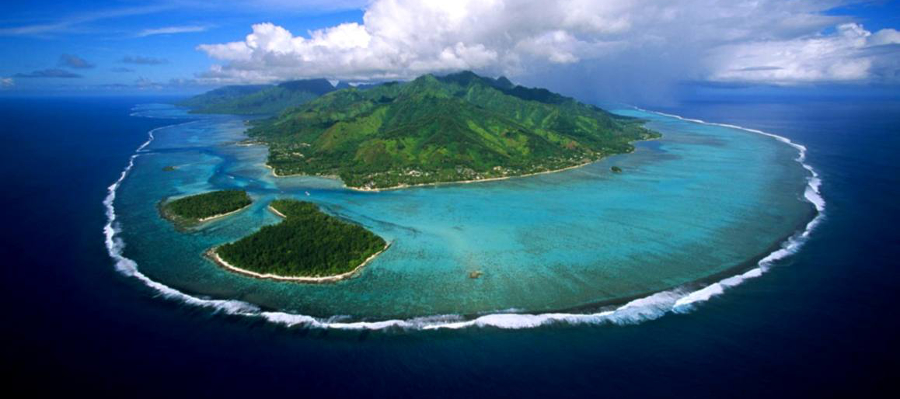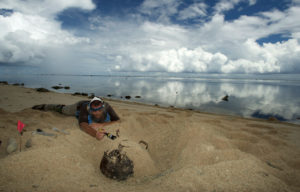
French Polynesia. Foto: CCBY dany13
World unites to save the seas
All nations have agreed to work together to save the oceans before 2030. It will not be easy, but history shows international cooperation can bring real change.
Share
Other categories
If you need a good argument for protecting the world’s oceans, take a deep breath. Half the oxygen you just inhaled originally came from the sea, according to a recent UN report that highlights the status of the world’s oceans and the value of protecting them. The oxygen comes from untold billions of algae; microscopic plants that produce the air we breathe, just like the plants that grow on land.
“The ocean is crucial for life on Earth, including for human beings,” says professor Katherine Richardson, one of the leading ocean experts at the University of Copenhagen. “Our entire natural world has evolved through an interaction between life in the ocean, life on land, and the climate”.
Oceans of opportunity
The vital oxygen is only one of many important resources provided by the sea. Every year, the world’s fishermen catch a total of about 80 million tonnes of fish, which provides 17 per cent of the total protein consumed by humanity. And that’s just the fish. If we count other types of seafood, such as shellfish and squid, the total food production comes to 156 million tonnes a year, according to the UN Food and Agricultural Organization (FAO). Together with aquaculture (fish farming), the ocean food production supports the livelihoods of 10 to 12 per cent of the world’s population.
In addition to lots of food, the oceans also provide prosperity in other ways, such as the opportunity for income and job creation from sustainable tourism. On average, half of the economy of the Caribbean states is based on the many foreign visitors attracted by the Caribbean sea and its beaches. In the Pacific Ocean, the coral reefs of Hawaii are estimated to be worth one billion dollars annually, of which more than a third is derived from tourism, according to the US National Oceanic and Atmospheric Administration (NOAA).
Fragile blue giants
While oceans cover more than 70 percent of the earth’s surface, their resources are not endless. In fact, the seas are very vulnerable to human actions. For decades, we have taken more fish out of the ocean than it can replenish, leading to a decline and in some cases a collapse of fish stocks. In the seventies, about 10 per cent of the world’s fish stocks were overfished, and in the following decades, the amount of overfished stocks tripled. Today, around one third of the world’s fish stocks are estimated to be overfished, while 7 to 13 per cent of stocks are considered collapsed, according to the UN report.
It’s not only the amount of fishing that’s destroying life in the seas. The way fishing is done also plays a big part. Destructive fishing methods, such as bottom trawling or blowing fish out of the water by dynamite continue to cause serious damage to coral reefs, sea grasses, cold water corals, and sponge grounds. When these vital habitats disappear, so do most of the fish that depend on them, leaving fishermen with empty nets. Even when such fishing methods are not used, huge amounts of unwanted fish and animals are caught by mistake in nets intended for other species, and then discarded dead. This unintended bycatch is estimated to account for around 40 per cent of the total global catch, and in addition to fish it kills more than 600.000 marine mammals and 85.000 sea turtles a year.
Hope for healthier seas
Despite these and many other threats to life in the sea, there is some hope. Countries are becoming increasingly aware of the value of keeping the oceans alive, and real progress has been made through international agreements. One example is the success of the 1986 decision to stop killing whales. Thanks to the ban on whaling, species such as the blue whale survived and are increasing in number, while the humpback whale, once hunted to the brink of extinction, is now thriving and considered ‘least concern’ on the list of endangered species maintained by the International Union for Conservation of Nature.
Ocean protection is also bubbling to the top of the international political agenda. For the last 15 years, the issue of protecting the seas only got a brief mention as a sub-point of the UN Millennium Development Goals that helped guide world development from 2000 to 2015. But when those goals reached their conclusion and were followed by the new Sustainable Development Goals for 2030 (also known as the Global Goals), maintaining life under water was declared as a goal in its own right, with a list of specific targets – a clear indication that all nations now recognise the need to save the seas.
States are taking action
While words won’t change anything on their own, there are also some signs that nations are starting to take action. The Global Goals come at a time when some developed countries have already been using their own territorial waters more sustainably for years, helping fish stocks to regrow. In the North East Atlantic, the percentage of sustainably harvested UK fish stocks that have returned to full reproductive capacity has increased steadily since 1990, from around 10 per cent in 1990 to nearly 50 per cent today. Further improvements are expected, following the 2014 reforms of the EU’s Common Fisheries Policy, which introduced legally binding commitments to fish at sustainable levels.
While these improvements let law-abiding fishermen catch more fish in the long run, problems persist with illegal fishery. But here too, there are signs of improvement. On the fifth of June this year, 57 nations, including the nations of the EU acting together, agreed to work together to stop illegal, unreported and unregulated fishing. The countries will cooperate better to make it much more difficult for law-breaking fishermen to land their illegal catch. In total, the nations of the agreement account for 64 per cent of the world’s fish exports. However, several of the countries most involved in illegal fishing, such as China and Russia, have not signed the agreement, which limits its effect. The agreement remains open to these states potentially joining at a later date.
Plastic – a persistent problem
While this kind of agreement shows promise to keep the oceans alive, some threats remain that are more difficult to solve. Plastic pollution has reached enormous levels, with up to 12.4 million tonnes entering the ocean every year, according to a study published in the journal Science. Once in the water, the plastic chokes wildlife and eventually splits into tiny invisible particles that end up in the seafood on our dinner plates. To solve the problem will require international efforts to ensure better waste disposal systems, and to stop using plastic as a disposable material. Some progress is now taking place. For example, many countries are banning plastic bags, or beginning to charge fees for them, while many countries recycle plastic bottles and other waste. But local solutions will not be enough to solve the problem. Since plastic is carried to the sea by rivers, and then swept around the world by the ocean currents, all countries must eventually be part of the solution.
Climate change hits the ocean hard
A less visible, but in many ways even more serious problem is the current extremely rapid man-made climate change.
Global warming is not only heating the land, but also the oceans. When the water gets too hot, coral reefs get shocked and weaken, and if temperatures don’t drop fast, reefs can die on a massive scale. In addition to the heat, a quarter of the air’s CO2 is absorbed by the oceans, which makes the seawater more acidic. This dissolves the calcium that many types of important sea creatures need to build their shells, including corals, crabs, lobsters, shrimp, and mussels.
Ocean expert Katherine Richardson says climate change is the most serious current threat to life in the sea.
“If we continue to emit CO2 like we do today, it is estimated that there will not be anywhere in the world where coral reefs can exist in 2060, and within just 20 years we are likely to see big areas of the Pacific Ocean become deprived of oxygen due to increased bacterial growth caused by rising temperatures. This risks creating dead zones devoid of life,” says Katherine Richardson.
While many fanciful solutions to climate change have been proposed, the only effective solution still seems to be to limit emissions of the so-called greenhouse gasses. Last year, world leaders came together in Paris to agree on limiting global warming to 2 degrees Celsius, with an ambition to stop at 1.5 degrees. But since the world may already be locked into a warming of 1.5 degrees, due to the greenhouse gases already released, stopping at 2 degrees will need very deep, coordinated and rapid cuts to emissions in record time. There are some signs this may now be underway, as world investments in green energy are booming, according to the United Nations Environment Programme (UNEP).
In spite of all the problems listed in this article, Katherine Richardson remains highly optimistic when asked if there’s any hope that the many problems will be solved:
“Can we save our oceans? Of course we can – we now understand what consequences our actions have for life in the sea, and what it will take to minimise our impact. Knowledge is power”.







